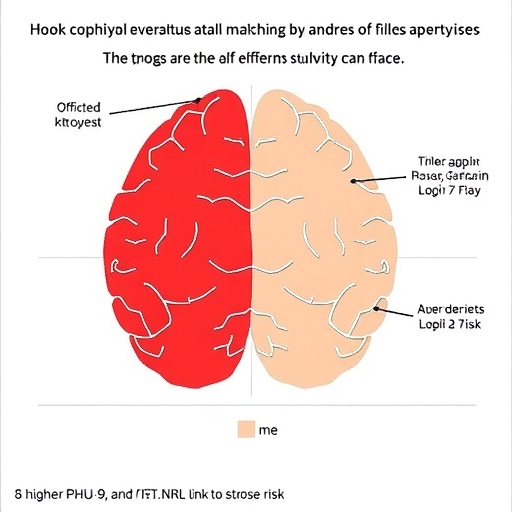In a groundbreaking analysis of nationwide health data, new findings reveal a significant connection between depressive symptoms, inflammation, and the risk of severe cardiovascular events. Utilizing data from the National Health and Nutrition Examination Survey (NHANES) spanning 2005 to 2018, researchers have demonstrated that individuals exhibiting higher depressive symptom scores alongside increased neutrophil-to-lymphocyte ratios (NLR) face markedly elevated risks of stroke, all-cause mortality, and major adverse cardiovascular events (MACE). This study shines new light on the intricate interplay between mental health and systemic inflammation as drivers of critical health outcomes.
NLR is a readily obtainable biomarker derived from routine blood tests and reflects the balance between neutrophils, which are often increased during inflammatory responses, and lymphocytes, key players in immune regulation. Meanwhile, the Patient Health Questionnaire-9 (PHQ-9) score remains a clinically validated tool quantifying the severity of depressive symptoms. By leveraging these measurable indices, the research team endeavored to explore their individual and combined effects in predicting long-term health risks within a broad, demographically diverse population.
The investigation employed weighted Cox regression models accounting for the nationally representative sample of over a decade of NHANES participants aged 20 and above. This rigorous analytical approach allowed for accurate estimation of hazard ratios reflecting the relative risk associated with increasing NLR levels and PHQ-9 scores on incident stroke events, mortality from any cause, and MACE—which comprises nonfatal myocardial infarction, stroke, and cardiovascular death. The statistical validation underscored significant positive correlations between both elevated inflammatory markers and depressive severity with adverse outcomes.
More specifically, participants demonstrating higher NLR levels were found to experience an approximately 40% increased hazard of all-cause mortality and nearly double the risk of MACE events relative to lower-NLR counterparts. Correspondingly, individuals with more pronounced depressive symptoms, indicated by elevated PHQ-9 scores, exhibited a 76% higher risk of mortality and a similar heightened risk of major cardiovascular incidents. These associations persist even after controlling for common confounders, underscoring the independent prognostic value of these biomarkers.
Perhaps most striking was the synergistic effect unveiled through joint analysis. Participants concurrently exhibiting PHQ-9 scores of 10 or greater, indicative of moderate to severe depressive symptoms, alongside elevated NLR levels bore the highest cumulative risk. Their likelihood of experiencing all-cause death or major cardiovascular events substantially exceeded that of participants presenting with either risk factor alone. This compelling evidence highlights the compounded vulnerability generated by the intersection of psychological distress and immune activation.
Delving deeper, mediation analyses revealed that the neutrophil-to-lymphocyte ratio partly mediates the relationship between depressive symptoms and adverse cardiovascular outcomes. Although the mediated proportion varies—with NLR accounting for approximately 0.6% of stroke risk and between 4.8% to 5.9% for mortality and MACE respectively—this finding provides pivotal mechanistic insight. It suggests that systemic inflammation, as quantified by NLR, could function as a biological conduit through which depression exacerbates vascular risk.
These discoveries bear profound implications for both clinical practice and public health policy. The identification of NLR as a potential inflammatory mediator linking mental health disturbances with cardiovascular morbidity offers a tangible target for risk stratification and intervention. Integrating assessments of depressive symptoms and inflammatory markers may pave the way for personalized preventive strategies aiming to curtail the progression to stroke or fatal cardiovascular events.
Moreover, the accessibility and low cost of measuring NLR and administering the PHQ-9 questionnaire enhance the feasibility of widespread screening initiatives. In primary care and community settings, these tools could enable more nuanced health monitoring, early identification of high-risk individuals, and timely referrals for comprehensive mental and cardiovascular evaluations. Addressing systemic inflammation alongside traditional cardiovascular risk factors may represent an innovative dual-pronged approach to improve patient outcomes.
From a research perspective, the NHANES cohort provides a unique and robust dataset, enriching the validity of these conclusions through its extensive demographic coverage and longitudinal follow-up. Future investigations will be required to explore underlying biological pathways, interventions modulating inflammation and depression, and their integration within multidisciplinary care frameworks. Such studies will also benefit from examining genetic, environmental, and lifestyle moderators that influence these complex interactions.
This study underscores the pressing intersection between mental health and physical disease, reiterating the necessity to transcend traditional silos in healthcare. The entwined pathophysiology of depression and inflammation emerges as a crucial determinant of stroke and cardiovascular mortality risk, challenging clinicians and researchers alike to incorporate psychosomatic dimensions into cardiovascular risk assessments. In doing so, we open new avenues for mitigating the burdens of these leading causes of death.
Importantly, while the inflammatory milieu represented by NLR explains only part of the influence depressive symptoms exert on adverse events, it encapsulates a pivotal mechanistic link emphasizing the broader relevance of immune dysregulation in mood disorders. These insights further validate calls for integrated mental-health services addressing somatic health, thereby enhancing holistic patient care and potentially improving longevity and quality of life.
In conclusion, the joint assessment of PHQ-9 scores and neutrophil-to-lymphocyte ratio within this comprehensive population database elucidates a powerful combined predictor of stroke, mortality, and cardiovascular risk. Recognizing the biological interdependence of psychological distress and inflammation may catalyze paradigm shifts in preventive cardiology and psychiatric practice, heralding more efficacious strategies to counteract these intertwined health threats. The translational potential of these findings beckons concerted efforts to embed such biomarkers in routine clinical workflows as part of the next frontier in precision medicine.
Subject of Research: Association of depressive symptoms and neutrophil-to-lymphocyte ratio with stroke risk, all-cause mortality, and major adverse cardiovascular events
Article Title: Higher PHQ-9 score levels and neutrophil-to-lymphocyte ratio are associated with increased risks of stroke, all-cause mortality, and MACE in NHANES 2005–2018
Article References:
Liao, J., Zhang, A., Cong, Y. et al. Higher PHQ-9 score levels and neutrophil-to-lymphocyte ratio are associated with increased risks of stroke, all-cause mortality, and MACE in NHANES 2005–2018.
BMC Psychiatry 25, 772 (2025). https://doi.org/10.1186/s12888-025-07198-0
Image Credits: AI Generated




